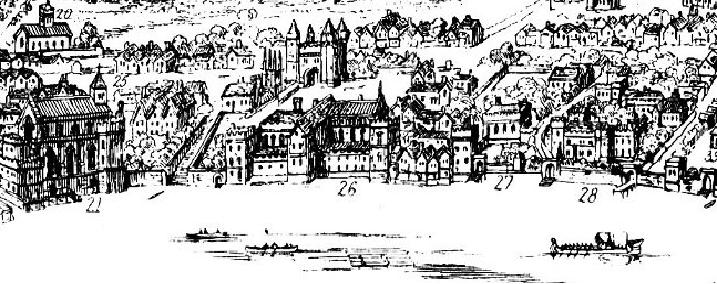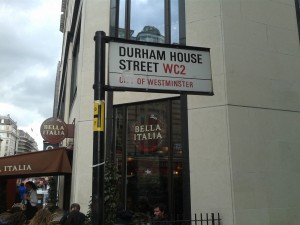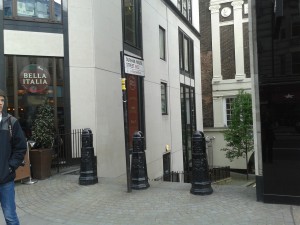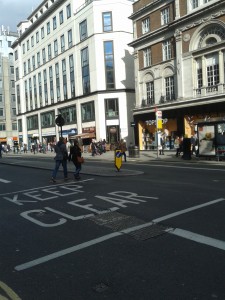Wedding of Lady Jane Grey
On 25th May 1553 Lady Jane Grey and Lord Guildford Dudley were married at Durham House.
Ives writes that ‘The earliest evidence of Jane’s betrothal to Guildford is a warrant dated 24 April 1553 to deliver ‘wedding apparel’ to the bride and groom, their respective mothers and also the lady marquis of Northampton’(p185, Ives). He continues that this included ‘parcels of tissue and cloths of gold and silver, forfeited by the Duke and Duchess of Somerset’and that ‘Edward may also have sent jewels, specially for Jane to wear’(p.185, Ives).
De Lisle describes how ‘Durham House witnessed a triple wedding’(p.102, de Lisle). The other couples were Lady Katherine Grey and Lord Henry Herbert and Lady Catherine Dudley and Lord Henry Hastings. The celebrations included ‘games, jousts, a great feast and two masques, one performed by the men of the court, the other by the women’ (p.102, de Lisle).
There is some debate about whether the wedding took place on the 21st or the 25th of the month. De Lisle, Ives, Guy and Lipscomb all give the 25th as the date. De Lisle writes that, ‘The date is almost always given as the 21st but this is drawn from Commendone writing after the event. It was booked to take place on a Thursday… and when I calculated the day from other known dates – e.g. Jane’s entry to the Tower – it confirmed my suspicion that it was the 25th’ (p.330, footnote 1, de Lisle).
Ives notes that ‘English observers do not mention the celebrations’ (p. 185, Ives). However, the wedding was reported by the Holy Roman Empire’s Ambassador to England, Jehan Scheyfve, as taking place on the 25th.
These are his reports:
May 12. Vienna, Imp. Arch. E. 20.Jehan Scheyfve to the Emperor.
‘This Whitsuntide the marriage of the Duke of Northumberland’s son to the eldest daughter of the late Duke of Suffolk is to be celebrated. They are making preparations for games and jousts. The King has sent presents of rich ornaments and jewels to the bride; moreover, by means of the Duke of Northumberland’s intercession, the Earl of Pembroke’s eldest son, who is at present very ill, is to marry the said Duke of Suffolk’s second daughter, and the third is to wed Lord Grey’s son. The Duke of Northumberland will give his daughter to the son of the Earl of Huntingdon, Knight of the Order, and a member of the Council.’
From: ‘Spain: May 1553’, Calendar of State Papers, Spain, Volume 11: 1553 (1916), pp. 37-48 – British History Online.’
May 30. Vienna, Imp. Arch. E. 20.Jehan Scheyfve to the Emperor.
‘On the 25th of this month were celebrated the weddings of my Lord Guilford, son of the Duke of Northumberland, to the eldest daughter of the Duke of Suffolk; of the Earl of Pembroke’s son to the second daughter; and of the Earl of Huntingdon’s son to the daughter of the Duke of Northumberland. The weddings were celebrated with great magnificence and feasting at the Duke of Northumberland’s house in town. The Order of the Garter was not called together on Whit Sunday; the meeting has only been postponed.’
From: ‘Spain: May 1553’, Calendar of State Papers, Spain, Volume 11: 1553 (1916), pp. 37-48 – British History Online.’
Location
Durham House was located on The Strand.
Giles Tremlett describes Durham House in the 16th century.
‘Durham House was a grand, solid-looking bishop’s palace in the smartest part of suburban London. It was one of half a dozen large, noble houses with extensive gardens strung along the River Thames by the Strand. Maps from later in the century show a short drive leading down to a two-storey palace whose broad facade, punctuated by a pair of three-storey towers, lay directly on the river. The main house sat around a courtyard. A walled garden looked out over the Thames towards Lambeth and its marshes. The river here was busy with the lighter craft that operated above London Bridge, including barges, barks and swift rowing boats ferrying people along the city’s main thoroughfare. Amongst her riverside neighbours were the most palatial houses of London’s grandest suburb, including York House and the Savoy palace’ (p.104-5, Tremlett).
Tudor History of Durham House
May 1502 – Katherine of Aragon lives at Durham House following the death of her husband, Arthur, Prince of Wales.
1528 – Cardinal Wolsey stayed there while building work was carried out at York Place. He resigned the See of Durham in late 1529. He was succeeded by Cuthbert Tunstall in 1530.
1529 – Sir Thomas Boleyn, Earl of Wiltshire, was in residence.
1532 – Anne Boleyn stayed there in May.
1536 – Granted to King Henry VIII who used it for the entertainment of Ambassadors.
Edward VI lived there before he became King.
1550 – Granted to Princess Elizabeth under the terms of Henry VIII’s will.
1553 – Ownership was granted to John Dudley, Duke of Northumberland.
1553 – 25th May – Weddings of Lady Jane Grey, Guildford Dudley, Katherine Grey, Henry Herbert, Catherine Dudley and Henry Hastings.
Late 1553 – Mary restored Durham House to the Bishop of Durham.
1554/1555 – Residence of the Spanish Ambassador. King Philip also stayed there.
1559-1565 – Residence of the Spanish Ambassador.
1565 – Wedding of Sir Henry Knollys attended by Elizabeth I.
1565 – 1579 – Sir Henry Sidney in residence.
1591 – Sir Walter Ralegh in residence.
From: ‘Durham Place’, Survey of London: volume 18: St Martin-in-the-Fields II: The Strand (1937), pp. 84-98. URL: http://www.british-history.ac.uk/report.aspx?compid=68277
Durham House Today
All that remains of Durham House today is the street sign ‘Durham House Street’, showing where the house once stood.
Sources
Guy, J. (2013) The Children of Henry VIII, Oxford University Press.
Ives, E. (2009) Lady Jane Grey: A Tudor Mystery, Wiley-Blackwell.
Lipscomb, S. (2012) A Visitor’s Companion to Tudor England, Ebury Press.
De Lisle, L. (2010) The Sisters Who Would Be Queen: The Tragedy of Mary, Katherine and Lady Jane Grey, HarperPress.
Tremlett, G. (2010) Catherine of Aragon: Henry’s Spanish Queen, Faber and Faber.
Calendar of State Papers, Spain, Volume 11: 1553 (1916), pp. 37-48. URL: http://www.british-history.ac.uk/report.aspx?compid=88480 Date accessed: 08 April 2013.
Survey of London: volume 18: St Martin-in-the-Fields II: The Strand (1937), pp. 84-98. URL: http://www.british-history.ac.uk/report.aspx?compid=68277 Date accessed: 14 May 2013.
Map of London http://en.wikipedia.org/wiki/Panorama_of_London Date accessed 12 May 2013.
Calendar of State Papers, Spain, Volume 11: 1553 (1916), pp. 37-48. URL: http://www.british-history.ac.uk/report.aspx?compid=88480 Date accessed: 08 April 2013.
Calendar of State Papers, Spain, Volume 11: 1553 (1916), pp. 37-48. URL: http://www.british-history.ac.uk/report.aspx?compid=88480 Date accessed: 08 April 2013.









































